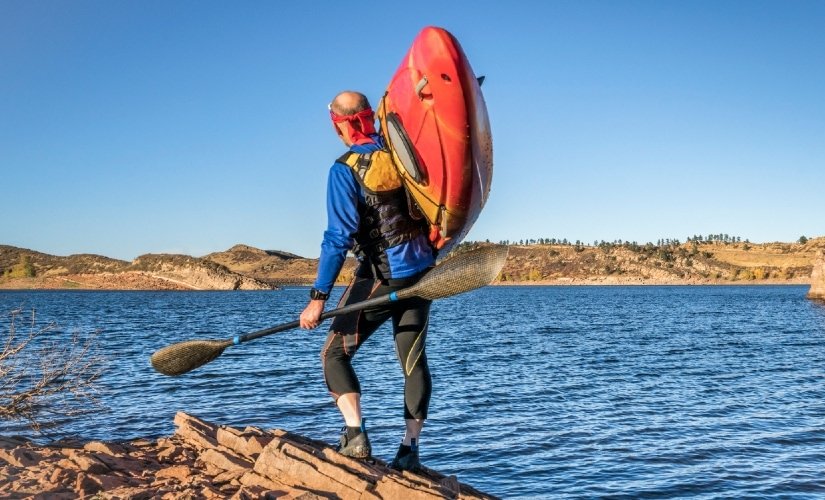Portages are a less enjoyable part of kayaking. Nobody likes carrying a heavy kayak and gear, even over a short distance. It is tiring and frustrating.
But kayak portage is not something you can avoid as a kayaker. While you don’t have to love it, you need to learn how to do it.
So, here is how you can portage your kayak as efficiently and painlessly as possible.
Key Takeaways
- Plan and scout the route in advance so you can prepare for the portage and pack accordingly. Bring a kayak trailer if your kayak is too long and heavy.
- Once you get to the portage, bail out any water from your kayak first then balance the weight of your luggage in the hatches.
- Lift your kayak onto your shoulders using one of two methods: lifting it from the side or lifting it from the end.
- Walk carefully, rest when needed, and use carry straps or pads to make the portage easier and less painful.
- Take two trips if you have too much stuff.
Prepare in Advance
You may have practiced carrying your kayak at home a hundred times. But there is more to preparing for a portage than that.
1. Plan Your Route
Kayakers love adventures; and sometimes you can decide to take a spontaneous trip. But if you come across a portage with unpleasant surprises, that will ruin the experience for you.
What is the importance of planning your route?
So you can check it out. It is one thing to look at a map or google a route, and it is another to see what it is like in real life.
Before your kayak trip, go there without a boat and inspect it. Know how long the portage is, what obstacles are there, and every other detail. This way, you will know what you are preparing for when packing your stuff.
Speaking of…
2. Pack Wisely

Once you see what the terrain is like and the distance you will have to carry your kayak, you can pack accordingly. Ideally, you should have one backpack that fits all your luggage.
Avoid carrying things you won’t need.
You don’t want to be carrying a kayak and several other small bags. It is easy to lose stuff that way.
If you have a lot of luggage, make sure you have as few bags as possible.
The more the bags, the more the number of trips you’ll have to make; unless the bags can fit into your kayak hatches.
The bag(s) should also be wearable.
3. Bring a Kayak Trailer
Some kayaks are too long and heavy. Carrying them on your shoulders would be awkward. And even with a smaller boat, the terrain may be too rough and the distance too long. Instead of wearing yourself out, you can bring a kayak trolley to make your work easier.
How to Portage a Kayak
Once you have your kayak out of the water, it is time to undertake the task you have been dreading. But you will see that it is not as bad as you make it out to be.
Step 1: Drain Water from the Kayak
This is something that many people don’t even think about. But if there is water in your yak, the portage will be harder than it needs to be.
So the very first thing you should do is bail the water out. It can make the kayak heavier and nobody wants that.
Step 2: Organize Your Gear
Take your time here. Do it wrong and you will make the process more painful.
This step will be different depending on the type of kayak and the luggage you have.
If you are a kayaker going camping or for an overnight excursion, you probably have a sea kayak with hatches and a lot of gear. All of it may not fit into your backpack.
Put as much into the bag as possible. Having too much stuff in the kayak will make it heavier. If you have some luggage left, organize it in the hatches. Make sure you balance the weight in the front and rear hatch.
Here is a detailed video to give you an idea of how to arrange your things.
Note: you can decide to carry your gear and you kayak all in one trip as in the video above. Alternatively, carry the kayak first and come back for the bags—or vice versa.
Step 3: Carry the Kayak
Now, this is the tricky part, especially if you have a heavy kayak and/or you’re a smaller paddler. But sometimes, it is less about your strength and more about how you do it.
Some paddlers can easily lift their yaks and place them on their shoulders. However, it is not that simple for everybody.
There are two ways of lifting your kayak onto your shoulders.
Method 1
- Have your kayak on the ground, with the bow facing where you are headed.
- Stand on one side. Ensure you are standing at the center so the kayak will be balanced when you lift it.
- Grab the cockpit rim and place the kayak on its side, with the cockpit facing away from you.
- Squat slightly and lift the kayak onto your thighs by grabbing the rim with both hands.
- With the boat resting on your thighs, and one hand holding the side of the rim closest to you, reach out the other hand and grab the kayak by the far rim.
- Next, lift the kayak over your head, with the rims resting on your shoulders.
This video shows the technique accurately. (Only carry the boat on one shoulder if it’s super lightweight and the distance is short).
Method 2
- Have the kayak on the ground with the bow facing where you are headed.
- Stand on one side and place the yak on its side, with the cockpit facing away from you.
- With one hand on the near rim and the other on the far rim, lift the stern and tilt the boat. Now the cockpit should be over your head.
- Slowly rest the rims on your shoulders and lift the bow from the ground.
Note: when carrying your kayak, it should be at an angle, with the stern closer to the ground. Furthermore, you can use a yoke or kayak portage pad to prevent the rims from digging into your shoulders.
Remember to walk carefully and don’t let your mind wander off.
Once you get to the end of your portage, gently use the above methods (steps in reverse) to put it down.
Tips for Portaging Your Kayak
Take two trips if you have to: you’ll see kayakers carrying a fully packed backpack and kayak full of gear at the same time. Don’t feel pressured. If your kayak is too heavy or you have too much stuff, take two or more trips. There is no need to hurt your shoulders or back.
Rest: on a longer portage, it is okay to rest every few minutes. Put the kayak down and stretch if you are getting too tired.
You can use carry straps: for very light boats, a kayak strap makes sense. It is easy to use and you don’t have to lift the yak over your head.
Conclusion
Portaging a kayak is not as hard as you thought, is it? Preparing in advance and scouting the route helps you know what to expect and how to prepare. This, in turn, will make the portage process much easier. And if you follow the steps above, portages will become less tedious for you.
Do you have any questions about how to portage a kayak? Feel free to ask us below. Happy kayaking!

